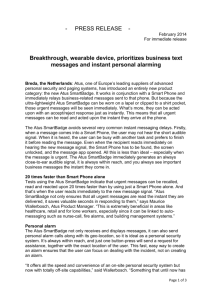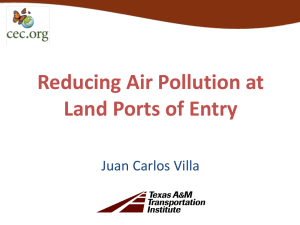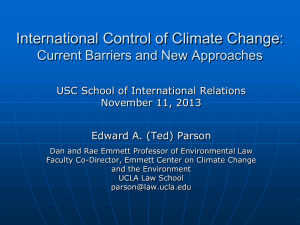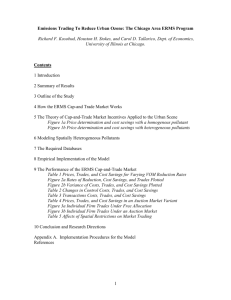EMISSION REDUCTION MARKET SYSTEM
advertisement
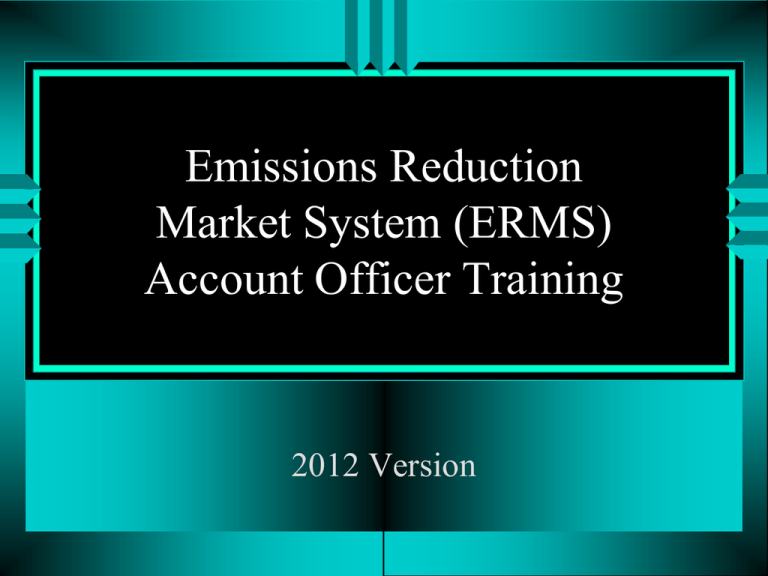
Emissions Reduction Market System (ERMS) Account Officer Training 2012 Version Basics Purpose of ERMS Contribute to attainment Minimize costs of further reduction by using a “market based approach” providing flexibility and allowing sources to determine the best way to reduce emissions Maintain the “status-quo” for current control programs 3 Past: Command and Control Rules developed based on industry type (e.g., printing, coating, chemical manufacturing) All companies required to implement the same reduction percentage • Cost not considered per company • Sometimes had a threshold for implementation • Usually not “one size fits all” 4 ERMS: Market Based Overall reduction mandated Allotments (emissions) given to the companies based on a baseline Up to the companies to determine how/if reductions are made • Make reductions and have allotments to sell • May be cheaper to buy allotments rather than reduce 5 Possible Approaches Upgrade control measures on existing units where it can be done most economically and effectively Enhance control measures when existing units are replaced Switch production out of the trading season Purchase ATUs 6 Affected Sources Stationary sources located in the Chicago ozone nonattainment area • Cook, DuPage, Kane, Lake, McHenry and Will counties • Aux Sable Township, Goose Lake Township in Grundy county and Oswego Township in Kendall county 7 Affected Sources - continued Required to obtain a Clean Air Act Permit Program (CAAPP) permit OR Federally Enforceable State Operating Permit (FESOP) VOM emissions of at least 10 tons per season (May 1 - September 30) 8 Affected Sources - Exemptions Can accept a limit of 15 tons/season • 10 tons/season is the threshold for identifying you as a participating source, but accepting a limit of 15 tons/season will keep you out of being a participating source in ERMS Make a reduction of 18% from your baseline • Participating sources make a 12% reduction 9 Types of ERMS Sources Types of ERMS Sources Participating Source New Participating Source General Participant Special Participant 11 Participating Source Operating prior to May 1, 1999 Located in the Chicago nonattainment area Potential to emit >=25 tons/year of VOM Required to obtain a Title V (CAAPP) or FESOP (Federally Enforceable State Operating Permit) permit VOM emissions >=10 tons/season 12 New Participating Source Not operating prior to May 1, 1999 Located in the Chicago nonattainment area Potential to emit >=25 tons/year of VOM Required to obtain a Title V (CAAPP) permit VOM emissions >=10 tons/season Do not get an annual allotment 13 General Participant Not a Participating Source Not a New Participating Source Any person/entity that obtains a Transaction Account • Can think of this as a “broker” Can buy and sell ATUs Need to have a trained account officer 14 Special Participant Any person/entity that registers with the Agency Cannot sell ATUs Can buy ATUs • Any purchased ATUs are immediately retired No account officer training needed 15 Baselines, Allotments & Reconciliation Allotment Trading Unit (ATU) The “currency” of the ERMS Equivalent of 200 pounds VOM emissions Each ATU is valid for the season of issuance and the following season • Unless used for emission compensation 17 Baseline Emissions Based on historical emission data • Adjusted upward for over-compliance • Adjusted downward for non-compliance • Can substitute years Allotment of ATUs will be set from the baseline emissions • generally reduced by 12% • Allotment amount included in your permit 18 Exclusion from Further Reductions Insignificant emission units Emission units complying with NESHAP or MACT Fuel combustion units (e.g., boilers and engines) Emission units where a LAER demonstration was approved 19 Baseline Years Average of the two highest years of 1994, 1995 or 1996 • No justification needed Can substitute any year from 1990-1993 or 1997 if that year is more representative • Requires justification • Substitute one whole year 20 Emission Calculation Methodology The methodology used to calculate baseline emissions will be included in your permit • Must be used to calculate emissions for the season – no deviations • Changes to calculation methodologies require a permit revision – Baseline and allotment will be recalculated based on the new methodology 21 Annual Allotment Each year the number of ATUs in your permit will be deposited in your account automatically • Historically done in March/April • No notification • List will appear under the Allocation Reports menu option of the web page 22 Reconciliation Period three months (October – December) following seasonal allotment period Time to compile actual seasonal emission data Submit seasonal component of annual emission report The 23 Reconciliation Period - continued Conduct end of year trades • Can trade throughout the whole year trades agreed to by December 31st can be counted towards the seasonal emissions for that year Only • We don’t close the books at midnight December 31st, but wait a few days for paper trades to come in 24 Seasonal Emission Reports Seasonal Emission Reports Applies • • • • to Participating sources New Participating sources 18% reduction sources 15 ton/season limit sources Due date • October 31 for < 10 emission units • November 30 for >= 10 emission units 26 Seasonal Reports – Content VOM emissions from May 1 – September 30 Adjustments due to variance, consent order, emergency condition and so forth Number of ATUs that equate to the seasonal emissions HAP emissions for the season Actual 27 Seasonal Report – HAPs HAPS = Hazardous Air Pollutants Report VOM HAPs if • Major for HAPs – >= 10 tons/year for any individual HAP – >= 25 tons/year for all HAPs combined • Subject to NESHAP/MACT – Report only those units subject to NESHAP/MACT • Report to TRI 28 Seasonal Reports – Checking Signature All emission units are reported Emission calculations performed correctly • We find many math errors • Calculation methodology needs to be the same as in the permit • Production rate is used as a reasonableness check 29 Compensation and Excursions Emission Compensation This is the IEPA retiring (subtracting) the amount of ATUs, reported on your seasonal report, from your transaction account Timing • Sometime in mid-January of each year when all previous year transactions have been entered and seasonal report has been accepted • Never before January 1 31 Excursion Occurs when your account does not hold enough ATUs to cover your seasonal emissions If an excursion occurs, you are not in violation The ERMS rule gives a mechanism for resolving an excursion 32 Excursion Penalty First excursion • Owe 1.2 times the amount of excursion Second (or more) excursion in a row • Owe 1.5 times the amount of excursion When multiplying by 1.2 or 1.5, if there is a fractional ATU, the value is always rounded up to the next higher ATU 33 Excursion Resolution Will send an excursion compensation notice Only two choices for resolution • Purchase from ACMA (default) • Take from next year’s allotment – Notify us within 15 days Choice is yours • If choosing ACMA, you will be sent a bill 34 Annual “Flow” of ERMS April: Allotment May – September: Emissions October – December : Reconciliation • Submit seasonal report • Trade as necessary (throughout the year) January: Compensation and Excursion 35 Other Facets of ERMS ACMA Alternative Compliance Market Account Reserve of ATUs managed by IEPA Receives ATUs equivalent to 1% of each year’s allotment (about 1000 ATUs) ACMA available during reconciliation period Cost is lesser of 1.5 times the average market price or $10,000/ton 37 Shutdowns All operations at a source shut down and the permit is withdrawn (or is revoked or terminated) 80% of allotted ATUs go to source and 20% to ACMA unless… Source makes arrangement to trade whole allotment to a general participant before shutting down 38 Emission Reduction Generators ATUs created for creditable reductions at permitted sources that are not participating sources Source needs to become a general participant or have a partner in ERMS who gets the ATUs Reductions must be real, actual and surplus (can’t be shifted elsewhere in the area) 39 Inter-Sector Receive ATUs for making reductions in area source or mobile source categories • Cars – Cash for clunkers • Switch from gas to electric lawnmowers • Reformulate coatings purchased by the public (only Intersector to date) • Etc. Request reviewed by the Agency 40 Quick Facts Quick Facts About 140 participating sources About 5 new participating sources About 90 sources with 15 ton/season exemption About 75 general participants About 7 special participants 42 More Quick Facts About 104,000 ATUs allotted each season • 100,000 from baseline • 2700 from Emission Reduction Generators • 1000 to ACMA Around 40,000 ATUs retired each year Around 59,000 ATUs expire each year 43 Buyers/Sellers Around 20 sources need to buy ATUs each year Remaining sources (around 120) are possible sellers A few (1-3) sources go into excursion each year • Mainly due to inaction on their part to buy ATUs 44 ATU Prices ($/ATU) 2011 = 2010 = $20.10 2009 = $19.32 2008 = $18.22 2007 = $14.86 2006 = $17.01 45 Transaction Account and Account Officers Transaction Account Database where ATUs are kept • Has a unique identification number for the entity • All allocations, trades, retirements and expirations occur in the database • Trade is not accepted until it is enacted in the database Think of it as your bank account 47 Account Officer A person who has been approved by the Agency who is responsible for one or more transaction accounts Transaction account • Must have at least one account officer • Can have multiple account officers An account officer may be associated with more than one transaction account 48 Account Officers Remember… • An account officer can freely trade ATUs in and out of the transaction account as long as he is associated with the account • If an account officer leaves a company, it is best to notify the Agency of that fact and that you wish to have him removed from the account – Account officer can still represent other accounts 49 Expedited Approval of Account Officer Used when an account officer unexpectedly leaves that position • Requested by the company • With expedited approval, the account officer can perform trades without training • Must take the account officer training within one year of request 50 Trades Types of Trades Trade • One-time only transaction Transfer agreement • Multi-year transactions (specify years) • Will be performed once per year (can specify date) • Can be open-ended 52 Trades Agency does not get involved • Up to the two parties to agree on price and any other issues Must be submitted and approved by IEPA to be official Confirmation of the trade will be sent to both parties 53 Trade Options Trade oldest first • default Specify number and expiration date • e.g., 50 ATUs expiring in 2013 Specify by ATU id • Not really necessary with option of specifying by expiration date 54 Submitting Trades Mail FAX • Must follow up with hard copy submittal Via ERMS web page • Can’t do transfer agreements • Will execute over night 55 ERMS Forms Transaction Account 113-ERMS Use this form to • Establish a new account for – Participating source – New participating source – General participant • Update information for an account 57 Special Participant 114-ERMS Use this form to • Establish a new account for – Special participant • Update account information for a special participant 58 Account Officer 111-ERMS Use this form to • Establish a new account officer • Update account officer information • Allows an account officer to remove himself from an account • Request training/expedited approval 59 Account Officer Designation 112-ERMS Use this form to • Link an account officer to a transaction account • Remove an account officer from a transaction account 60 Transaction Request 116-ERMS Use this form to • Submit a trade request to the Agency • Must be signed by both parties • Can come in two parts (buyer and seller) but we prefer them to be together 61 Transfer Request 118-ERMS Use this form to • Submit a transfer request to the Agency • Must be signed by both parties • Can come in two parts (buyer and seller) but we prefer them to be together 62 Cancel Transfer Agreement 122-ERMS Use this form to • Stop the processing of a transfer agreement • Must be signed by both parties • Can come in two parts (buyer and seller) but we prefer them to be together 63 Emergency Conditions 110-ERMS Use this form to • Submit an initial emergency conditions report • Submit the final emergency conditions report 64 Regular Access to ACMA 119-ERMS Use this form to • Request a purchase of ATUs from ACMA 65 Special Access to ACMA 120-ERMS Use this form to • Request a purchase of ATUs from ACMA Unlikely to occur Happens only if there are not enough ATUs in ACMA 66 Request Buy/Sell Notice 121-ERMS Use this form to • Have the Agency create a buy or sell posting for you This information can also be entered through the web page 67 Balance Correction Request 115-ERMS Use this form to • Request the Agency to look at any ATU balance issues you may have Or you can just e-mail 68 Seasonal Report Forms Emission Summary 100-ERMS Required Use this form to • Summarize emissions from other seasonal report forms • Certify the report 70 Actual Seasonal Emissions 100A-ERMS Required Use this form to • Report the seasonal emissions for each VOM emission unit at the source Include all emissions • Adjustments will be made on other forms 71 Units Constructed Prior to 1/1/1998 100B-ERMS Shouldn’t really be occurring now Use this form to • Report the seasonal emissions for emission units that had a construction permit prior to 1/1/1998 that don’t have three years of emission data 72 Major Modifications 100C-ERMS Use this form to • Report the seasonal emissions for emission units that had a construction permit prior to 1/1/1998 that don’t have three years of emission data 73 Emergencies 100D-ERMS Use this form to • Report the emissions for emission units that had an emergency We will check to make sure you have submitted an initial and final emergency conditions report 74 Variance, Consent Order, Compliance Schedule 100E-ERMS Use this form to • Report the emissions for emission units that are subject to – A variance – A consent order – A CAAPP compliance schedule 75 HAP Emissions 100F-ERMS Required for participating and new participating sources Use this form to • Report the HAP emissions for the source Report only VOM HAPs 76 ERMS Web Page Web Page www.epa.state.il.us/air/erms 78 Web Page Mainly HTML Online Transaction Requests • Requires download of Jinitiator – A java product from the Oracle Corporation – Safe to load on your computer • Doesn’t work with Windows Vista or Windows 7 79 Contents Various reports Allocation reports Historical Annual Performance Review Reports News and Items of Interest Overview FAQ 80 Contents – continued Agency contact information Average ATU prices ERMS Forms Online Transaction Requests 81 Reports Various reports available Click on appropriate report Some reports require selection criteria to be entered • Some can be entered in either/or – Starting/end account number and/or – Starting/ending date 82 Average ATU Prices Lists • Last month and last four week average prices • Previous and current ACMA average price ACMA average price calculated at the end of October, November, December and January 83 Online Transaction Requests Options • Log In View buy/sell postings • Don’t need to be logged in View current account balance • Don’t need to be logged in • Can view any account 84 View Buy/Sell Postings The screen allows you to select criteria to filter your selection Usually there are very few buy/sell postings so it is better to leave the selection criteria as is and run the query. Doing so will select all active buy/sell postings 85 View Current Account Balance Enter the account number you wish to view Balance will be reported by ATU expiration date 86 Log In Enter your account officer id and PIN Will have additional options once logged in • • • • Create/update buy/sell posting Create/update seller transactions Confirm buyer transactions Change PIN 87 Create/Update Buy/Sell Posting Do not use to make a trade • Used for the purpose of identifying people who want to buy or sell • Not used by the Agency in performing trades Enter information as appropriate Can always come back and change an active posting 88 Create/Update Seller Transaction Used to perform an on-line trade Must be initiated by the seller • Confirmed by buyer in a later step Can be done in two parts (on-line and paper) but that is not the preferred method Enter information as appropriate Will get opportunity to review before saving 89 Seller Transaction Can update the information on the transaction up until it is accepted by the buyer Make sure information is correct and save Notify the buyer that the transaction is available 90 Confirm Buyer Transactions Once selected, a list of transactions available to approve will be displayed • The transactions you see are based on your account officer id when the seller created the transaction Click on the Transaction ID field to view the transaction 91 Buyer Transactions Review the information to ensure it is correct • It is both party’s responsibility to ensure the information is what they agreed to If transaction is ok, accept it Otherwise inform the seller the information is not correct • Buyer cannot change the information presented 92 On-line Transaction Once accepted by the seller… • Cannot be revoked or updated by the seller • Cannot be revoked by the buyer Transaction will be performed overnight • Can notify Agency if it is needed to be processed sooner • No confirmation letter sent (can get data from Reports option) 93 PIN Best to change the PIN you are given Never expires Up to 8 characters/numbers Case sensitive No requirement in length, number of numbers, case, etc. Contact the Agency if you forget your PIN 94 Bureau of Air Air Quality Planning Section Contact • • • • information Buzz Asselmeier buzz.asselmeier@illinois.gov phone: (217) 524-4343 Web: www.epa.state.il.us/air/erms 95 Training Completed Send an e-mail to buzz.asselmeier@illinois.gov Include • Your name and phone number • The fact that you have read through the training slides (you can always e-mail me for any questions you may have) I will sent a certificate back to you 96
